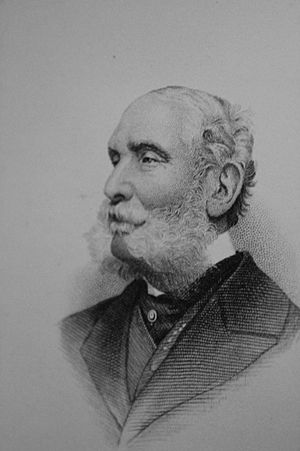Patrick Grant (Indian Army officer) facts for kids
Quick facts for kids
Sir Patrick Grant
|
|
|---|---|

Sir Patrick Grant
|
|
| Born | 11 September 1804 Auchterblair, Inverness-shire |
| Died | 28 March 1895 (aged 90) Royal Hospital, Chelsea, London |
| Allegiance | |
| Service/ |
Indian Army |
| Years of service | 1820–1877 |
| Rank | Field Marshal |
| Commands held | Madras Army Indian Army |
| Battles/wars | |
| Awards | Knight Grand Cross of the Order of the Bath Knight Grand Cross of the Order of St Michael and St George |
Sir Patrick Grant (born September 11, 1804 – died March 28, 1895) was a very important officer in the British Indian Army. He rose to the highest rank of Field Marshal. He fought in several major battles and played a key role during the Indian Mutiny. Later in his life, he became the Governor of Malta.
Contents
A Young Soldier's Start
Patrick Grant began his army career on July 16, 1820. He joined the Bengal Native Infantry as a young officer called an ensign. He quickly moved up the ranks, becoming a lieutenant in 1823 and a captain in 1832.
Early Military Roles
In 1834, Grant became a brigade major in Oudh, a region in India. He helped create a new army unit called the Hariana Light Infantry in 1836. After that, he worked in the army's main office, helping with important plans and movements.
Fighting in Key Battles
Sir Patrick Grant was involved in many important battles throughout his career. He often served under famous commanders.
The Gwalior Campaign
In December 1843, Grant fought in the Gwalior campaign. He was a deputy assistant to the adjutant-general at the Battle of Maharajpore. This was an important step in his military journey. He was promoted to major in 1844.
The Anglo-Sikh Wars
Grant played a big part in the First Anglo-Sikh War. He was the acting adjutant-general at several battles in 1845 and 1846.
- At the Battle of Mudki in December 1845, he was wounded twice.
- He also fought at the Battle of Ferozeshah in December 1845.
- He was present at the Battle of Sobraon in February 1846.
After these battles, he became the deputy adjutant-general of the Bengal Army and was promoted to lieutenant colonel.
Grant also took part in the Second Anglo-Sikh War. He fought in the Battle of Chillianwala in January 1849 and the Battle of Gujrat in February 1849. After these wars, he helped Sir Charles Napier in operations against the Pathan tribes in Kohat in 1850.
Rising Through the Ranks
Because of his bravery and skill, Grant was appointed as an aide-de-camp to the Queen in 1850. This was a special honor. He continued to be promoted, becoming a colonel in 1850 and a major-general in 1854. In 1856, he became the commander-in-chief of the Madras Army.
Role in the Indian Mutiny
The Indian Mutiny was a major uprising against British rule in India. When the top commander in India, General George Anson, died in May 1857, Sir Patrick Grant was called to take charge.
Directing Operations
As the acting Commander-in-Chief, India, Grant was responsible for leading the fight against the mutineers from Calcutta. He sent forces under Henry Havelock and James Outram to help the cities of Cawnpore and Lucknow, which were under attack. Even though the Viceroy of India wanted Grant to stay as commander-in-chief, another officer, Sir Colin Campbell, was sent from England to take the role. So, Grant returned to his command of the Madras Army.
Later Life and Honors
After his time in India, Grant returned to England in 1861. He continued to receive promotions, becoming a lieutenant-general in 1862 and a full general in 1870.
Governor of Malta
In 1867, Sir Patrick Grant was appointed Governor of Malta. This was a very important role, showing the trust placed in him. He retired from active military service in 1877 and was promoted to field marshal in 1883, the highest rank in the British Army.
Royal Hospital Chelsea
From 1874 until his death in 1895, Grant served as the governor of the Royal Hospital Chelsea. This hospital provides a home and care for retired soldiers. He passed away there on March 28, 1895.
Awards and Recognition
Sir Patrick Grant received several high honors for his service:
- Knight Grand Cross of the Order of the Bath (GCB): This is a very prestigious award given for outstanding military service. He received earlier versions of this award in 1846 and 1857.
- Knight Grand Cross of the Order of St Michael and St George (GCMG): This award is given for service to the Commonwealth or foreign affairs.
Family Life
Sir Patrick Grant was married twice. In 1832, he married Jane Anne Fraser-Tytler, and they had two children. After her passing, he married Frances Maria Gough in 1844. Frances was the daughter of another famous military leader, Field Marshal Hugh Gough, 1st Viscount Gough. Together, they had five children.
Images for kids





